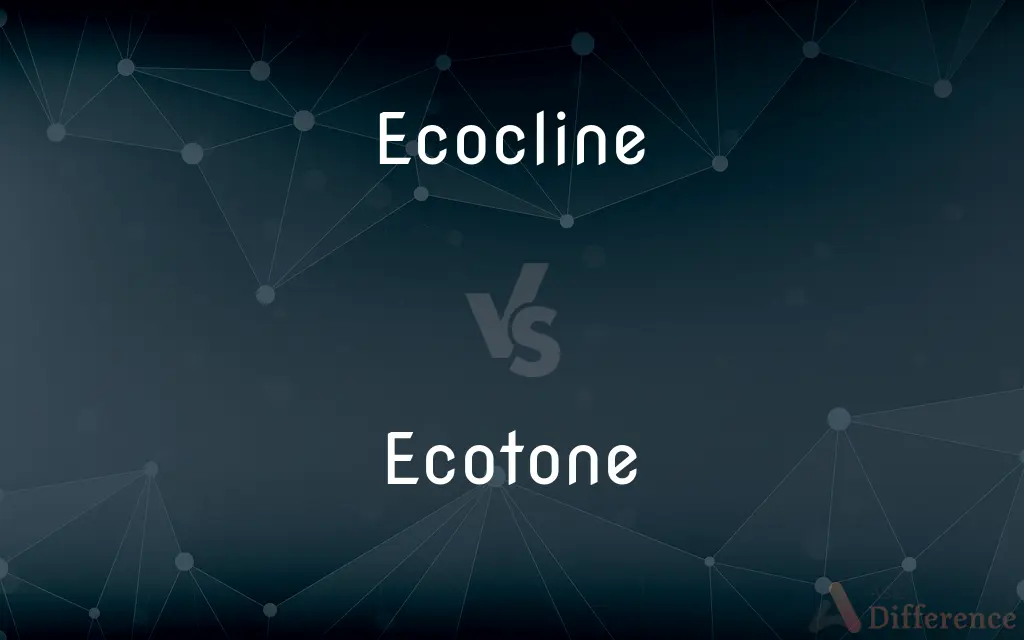Ecocline vs. Ecotone — What's the Difference?
By Tayyaba Rehman — Updated on October 27, 2023
Ecocline is a gradient of environmental change, while Ecotone is a distinct transition zone between two ecosystems.

Difference Between Ecocline and Ecotone
Table of Contents
ADVERTISEMENT
Key Differences
Ecocline represents a continuous and gradual change in environmental conditions over a certain distance or area. It's often linear and can be visualized as a slope or curve, indicating how one ecological factor changes across a gradient. On the other hand, Ecotone represents a sharp transition between two different ecosystems. This transition area often has species from both adjoining ecosystems and unique species of its own.
Ecocline can be thought of as a smooth gradient, like the change in altitude from a plain to a hilltop. As you move across an ecocline, you might see subtle shifts in species or environmental conditions. Contrarily, an Ecotone is like the sudden shift from a forest to a grassland. In this transition zone, you'll find a mix of species from both ecosystems, and potentially some that are specially adapted to the transitional environment.
In the context of biodiversity, an Ecocline might show a gradual increase or decrease of species richness or abundance as you move along the gradient. Ecotone, because of its nature as a transition zone, often has higher biodiversity. This is due to the overlap of species from both adjacent ecosystems and the species unique to the ecotone itself.
For conservationists and ecologists, understanding both Ecocline and Ecotone is crucial. Ecoclines help in understanding how species or communities might respond to gradual changes in conditions, like climate change. Meanwhile, Ecotones are critical for biodiversity conservation because they can harbor unique and sometimes endangered species.
Comparison Chart
Definition
Gradient of environmental change.
Distinct transition zone between two ecosystems.
ADVERTISEMENT
Nature
Continuous and gradual.
Sharp and distinct.
Biodiversity
Might show gradual changes in species richness.
Often has higher biodiversity due to overlap.
Visualization
Visualized as a slope or curve.
Visualized as a boundary or edge.
Example
Temperature change along a mountain slope.
Junction between a forest and grassland.
Compare with Definitions
Ecocline
Ecocline refers to a smooth transition of one ecological community into another over a specified range.
The subtle changes in soil pH across a meadow create an ecocline affecting plant distribution.
Ecotone
Ecotone represents the intersection of two biomes.
The area where a wetland meets a savanna serves as an ecotone.*
Ecocline
Ecocline denotes the gradual variations of species composition between communities.
The change in fish species from freshwater to brackish water illustrates an ecocline.
Ecotone
Ecotone is a region with a high diversity due to the overlap of neighboring habitats.
The mangroves, acting as an ecotone between marine and terrestrial ecosystems, teem with diverse species.
Ecocline
Ecocline is a continuous gradient in an ecological variable.
The shift in plant species as you ascend a mountain depicts an ecocline.
Ecotone
Ecotone is a boundary that witnesses species and environmental shifts.
The ecotone dividing grasslands from deserts is marked by shifts in vegetation and animal life.
Ecocline
Ecocline describes a linear sequence of habitats with changes due to factors like altitude or latitude.
Traveling from the equator towards the poles, one can observe an ecocline in temperature.
Ecotone
Ecotone defines the area of transition in which species from both neighboring communities are found.
Where freshwater rivers meet the ocean, the estuary acts as an ecotone with both freshwater and marine species.
Ecocline
Ecocline is a range over which ecological conditions change gradually.
Across a desert's edge, an ecocline in moisture levels can be observed.
Ecotone
Ecotone is a transitional zone between two ecological communities.
The boundary where a meadow meets a forest is an ecotone.
Ecocline
A gradation from one ecosystem to another when there is no sharp boundary between the two. It is the joint expression of associated community (coenocline) and complex environmental gradients.
Ecotone
An ecotone is a transition area between two biological communities, where two communities meet and integrate. It may be narrow or wide, and it may be local (the zone between a field and forest) or regional (the transition between forest and grassland ecosystems).
Ecotone
A transitional zone between two communities containing species characteristic of each.
Ecotone
A transition area between two adjacent ecological communities (ecosystems).
Common Curiosities
Can an ecocline be observed in a short distance?
Yes, ecoclines can exist over short or long distances, depending on the environmental gradient.
Why are ecotones considered biodiversity hotspots?
Ecotones have species from both adjoining ecosystems and may also have unique species adapted to the transitional conditions.
What is an ecocline?
Ecocline is a gradient where there's a continuous and gradual change in environmental conditions or species composition over a certain distance.
How do ecoclines help in studying climate change?
Ecoclines show how species or communities respond to gradual environmental changes, aiding predictions about shifts due to climate change.
Does every ecosystem have an ecocline?
Not necessarily. Ecoclines arise where there are gradual changes in environmental conditions, which might not be present in all ecosystems.
What defines an ecotone?
Ecotone is a distinct transition zone or boundary between two different ecosystems or ecological communities.
Are ecoclines always linear?
Mostly, ecoclines are visualized as linear gradients, but the nature of change can vary.
Are species in an ecotone only from the adjoining ecosystems?
While many species in an ecotone come from adjoining ecosystems, some are unique to the ecotone itself.
How are ecotones beneficial for conservation studies?
Ecotones, being biodiversity-rich, can harbor unique and sometimes endangered species, making them crucial for conservation efforts.
Are ecotones stable?
Ecotones can be dynamic, shifting due to factors like climatic changes or human interventions.
Can an ecotone be man-made?
Yes, ecotones can be natural or man-made, like the transition between cultivated land and natural forests.
Can multiple ecoclines exist in a single ecosystem?
Yes, depending on the number of environmental gradients, multiple ecoclines can exist in a single ecosystem.
Does an ecocline always represent a change in species?
Not always. While ecoclines often involve species changes, they can also represent gradients in environmental factors like temperature or pH.
What causes the formation of an ecotone?
Ecotones can form due to natural boundaries like rivers or human activities like deforestation.
How can one distinguish between an ecocline and ecotone in a field study?
An ecocline shows a gradual, often linear change in conditions or species, while an ecotone presents a distinct, sharp boundary between two ecosystems or communities.
Share Your Discovery

Previous Comparison
Emiter vs. Emitter
Next Comparison
Benefit vs. MeritAuthor Spotlight
Written by
Tayyaba RehmanTayyaba Rehman is a distinguished writer, currently serving as a primary contributor to askdifference.com. As a researcher in semantics and etymology, Tayyaba's passion for the complexity of languages and their distinctions has found a perfect home on the platform. Tayyaba delves into the intricacies of language, distinguishing between commonly confused words and phrases, thereby providing clarity for readers worldwide.














































